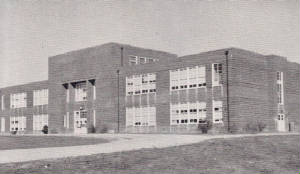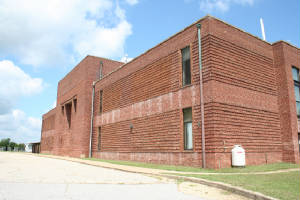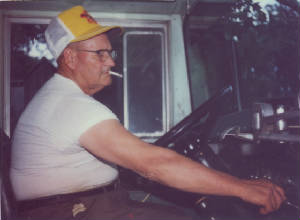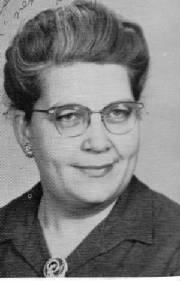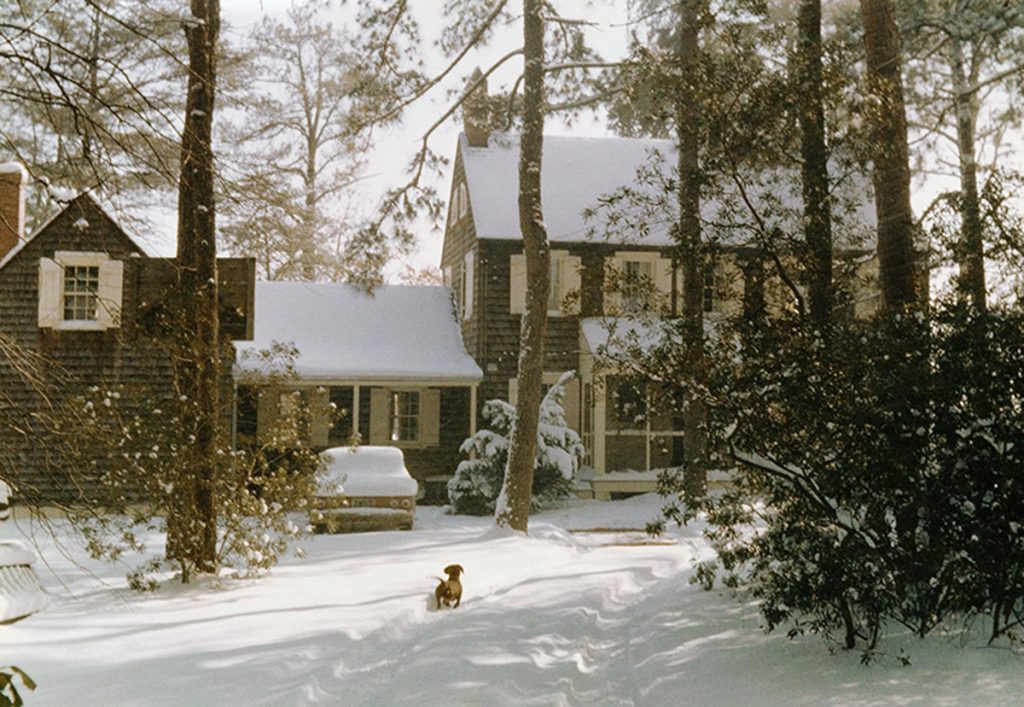
It used to snow
when we were kids,
all day, waist deep, pure white.
It would start with a few flakes
here and there
and grow into a windy swirl.
When I saw you
for the first time in forty years,
I remembered the snow.
You waiting at the top of the hill,
my eyes fixed on yours
as I pulled the sled behind me.
–Reunion, a poem by Joe Manning
It would have been a day like this one, perhaps a January or February in 1957 or 1958. The radio was tuned to WBAL in Baltimore, as I got ready for the 23-mile bus ride to Calvert County High School. My mother and I listened intently to the closing announcements, but were surprised and disappointed (me anyway) that my school wasn’t on the list. So I put on my boots and struggled half a mile down the snow-covered dirt road to catch Charlie Gray’s school bus.
Snow was a big deal in rural Southern Maryland, a rare delight that wreaked havoc for the road crews. Three inches were enough to almost shut down Solomons Island Road, the main drag that connected the lower and upper ends of the county – and my house to my school. As Charlie headed north out of Solomons, everyone wondered whether he was going to get us up St. Leonard Hill, as we called it. About a mile south of the tiny village of St. Leonard, the hill went a long way down, then a long way up.
As we got near, the level of raucous school bus chatter got louder. “Turn around Charlie,” someone yelled. “You won’t make it,” another shouted. “I don’t want to go to school,” added a third hopeful rider. As we slowly descended the first hill, it got quiet. Everyone held their breath. Then we started the slow, hard climb. Alas, Charlie made it, we exhaled, and 20 minutes later, we pulled up in front of the school, 30 minutes tardy.
On August 15, 2009, I attended my 50th high school reunion. I was called Howard back then, which is my middle name. By the time I had attended college for two years and served four years in the Air Force, my parents had sold the house and moved across the Chesapeake Bay to Maryland’s Eastern Shore. Because we were not originally from Southern Maryland, we had no family ties to Solomons. I finished college in upstate New York, married and moved to New England. I didn’t keep in touch with any of my classmates with any regularity. Since 1965, the only times I have been back were for my 10th, 20th, 30th, 40th and 45th reunions. This one seemed redundant, but how could I miss the 50th?
So my wife and I booked a hotel room in Prince Frederick, the town where the high school was, and drove 300 miles (halfway each day) through Connecticut, New York, New Jersey, Delaware and finally Maryland. Around noon on August 14, the day before the reunion, we headed into Calvert County on Route 4, now mostly a four-lane limited access highway. For much of the time, it runs almost parallel to the old Solomons Island Road, which is now Route 765.
We pulled into the parking lot of my old Calvert County High School, now the Calvert Middle School. The new high school, about a mile away, was built in 1962. The old brick building looked relatively the same, but the windows and the main entrance facing the road were filled in with bricks, and other buildings had been added on. I hadn’t been in the school since I graduated.
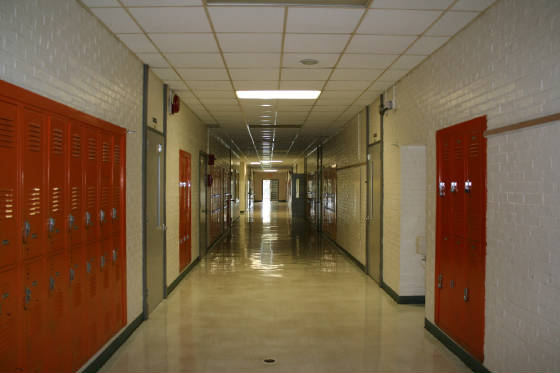
I had called ahead and asked if I could come in and take a look around. I was given permission, so we walked into the office. I had my camera, and after a warm greeting from the staff, I was told I could roam around as much I wanted. When I attended from 1953 to 1959, the school was two floors of classrooms along narrow hallways, a library, a gymnasium/auditorium, several administrative offices, and bathrooms at the end of the halls. There was also a third floor cafeteria, a claustrophobic room at the top of a narrow, winding staircase, which was an awful space for waiting in line for lunch.
Walking the halls and peering into the classrooms was disorienting. They seemed so much smaller. But things started to get familiar. I figured out where several of my favorite teachers’ classrooms were, even where my locker was in my senior year. The gym/auditorium is now the library, with a dropped ceiling. No basketball court, where Calvert usually knocked off Great Mills and Southern, but was destroyed by Lackey and La Plata. No stage where we had the senior class play and stood in our gowns on graduation day.
Just when I was about ready to give up looking, I found the narrow stairs leading up to the cafeteria. Up I went, and found the heating and air-conditioning systems, but no tables, chairs, trays and plastic forks. The bathrooms were a shock – same locations, same bathrooms – exactly as they were 50 years ago. I took as many pictures as I could. When we were leaving, the lady at the desk told me that a new middle school is opening down the road next year, and they might tear down my beloved old high school. Well, I got one last look.

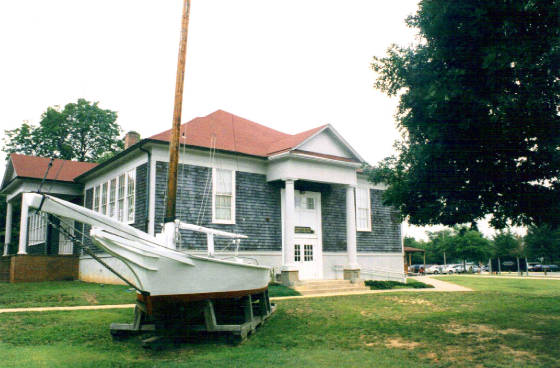
We drove south on Solomons Island Rd (the old road). Several times, it became the highway again, including on St. Leonard Hill, which looked the same, and surprisingly just as steep as I remembered it. We passed through familiar villages: St. Leonard, Port Republic, Lusby, and tiny Coster, which was more like a neighborhood with a general store. Lusby had changed the most; lots of strip malls, chain restaurants and convenience stores. Finally we reached Solomons.
Before we crossed the barely noticeable causeway that enters into the village of Solomons Island (it really is an island), we stopped at my other old school (Solomons Elementary), now the administration building of the Calvert Marine Museum, hugely expanded since my last visit. The old school building looked the same on the outside; inside it was completely changed. But just like the last time I was there, it still smelled like the old school. Someone explained that it’s the old oiled floors. The museum is terrific, and I saw plenty of familiar artifacts of the oyster industry that flourished there until its gradual decline starting in the 1970s.
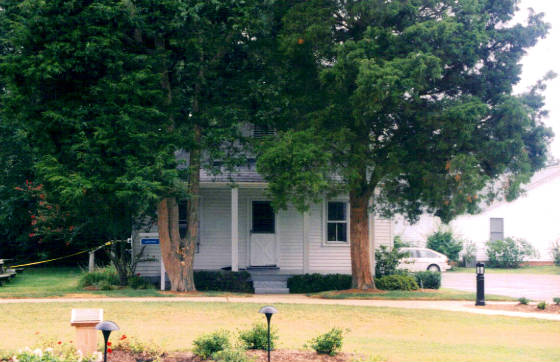
When we made the short drive around the densely populated island, we stopped at the ever-growing Chesapeake Biological Laboratory, which is right at the end of the island. My father worked there as a marine biologist, and my mother worked there as a librarian. Our first home in Solomons was a little cottage that we rented from the Lab, right behind the main building. It’s gone now, replaced by a parking lot. But our house several miles north in the Solomons village of Dowell was still there, along beautiful St. John’s Creek. It’s still an idyllic spot, though the house has not been well maintained. No one was home, so we walked around the property. My family lived there 14 years.
The day of the reunion, we explored the whole county, driving every back road I could remember. Then we went to the reunion at the huge Rod ‘n Reel, a landmark restaurant that’s been around for ages. It was a lovely and very moving event, simple, with lots of time for hugs and long conversations. I sat with my best buddies, most of whom had been my classmates all the way back in elementary school. There were 77 in our senior class, and more than 50 attended. It was the best and most meaningful reunion of all.
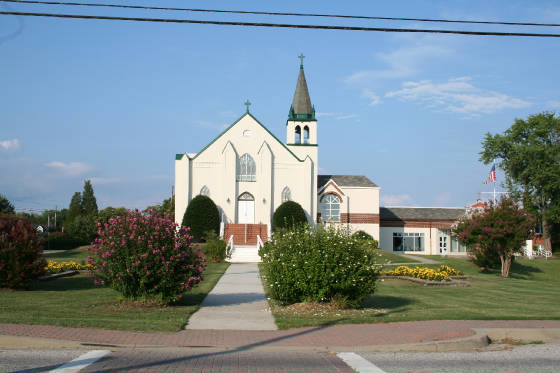
Before we left for home the next day (Sunday), we drove down to Solomons once more, so I could attend Mass at my boyhood church, Our Lady Star of the Sea. We had arrived about an hour early, so I bought a newspaper, and my wife and I sat on the front steps of the Chesapeake Biological Laboratory. After several minutes, I put the newspaper down and just stared longingly out at the Patuxent River, which flows into the Chesapeake Bay several miles out. I wondered how many thousands of times I pondered that scene as a child, as the boats buzzed by and the sea gulls squawked. Then we went to Mass.
The gorgeous church still stands, though they are building a new one now, vowing to preserve the original one for special events. The parish has grown so large that they held the Mass at the school building next door. Barely anyone looked familiar. I thought about the many Midnight Masses I attended with my late parents, the manger scene glowing in the front yard. When we headed north after the service, I looked back once more across the causeway, into the childhood world that I left long ago, and said a prayer that fate would bring me back yet another time.
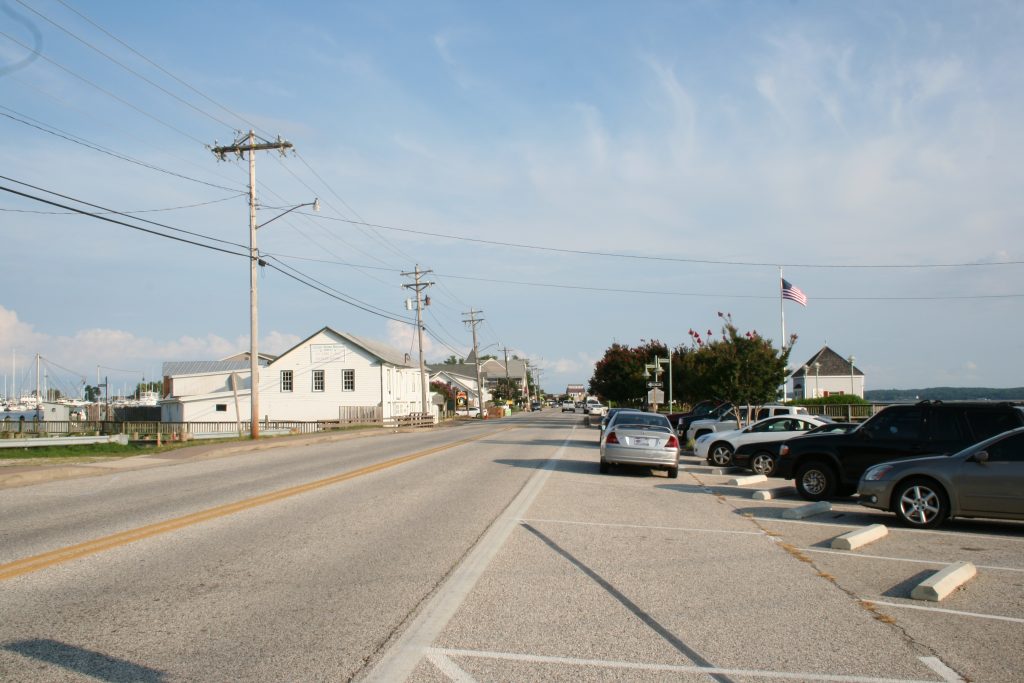
As we drove up St. Leonard Hill one final time, I remembered a magical winter adventure more than 51 years ago, an event that has become a legend. On Sunday, February 16, 1958, it snowed all day and all night, swirling into piles and drifts against the house. We got over a foot of the stuff – in Solomons! On Monday morning, not even the great Charlie Gray was going to be able to drag a school bus up the tiniest of hills. So we bundled up and turned into Eskimos for a week, taking time out for plenty of hot chocolate while we dried our duds on the floor register.
We forgot all about Mrs. June King’s weekend homework assignment to read an epic poem by a guy named Greenleaf or something. Every day it was the same, a frozen paradise. It took the county a week to dig out, and as far as we were concerned, it could have gone on forever. But come next Monday, the snow was melting and off the roads, and we hopped on the bus, said hello to Charlie and headed off to school. When we went to English class, Mrs. King welcomed us back, peered over her glasses, and said, “Today, we are going to discuss the poem I assigned. How many of you read it? Not a hand was raised. The poem was Snowbound, by John Greenleaf Whittier. For seven days, we had lived it. Life and poetry had become indistinguishable.
The sun that brief December day
Rose cheerless over hills of gray,
And, darkly circled, gave at noon
A sadder light than waning moon.
Slow tracing down the thickening sky
Its mute and ominous prophecy,
A portent seeming less than threat,
It sank from sight before it set.
A chill no coat, however stout,
Of homespun stuff could quite shut out,
A hard, dull bitterness of cold,
That checked, mid-vein, the circling race
Of life-blood in the sharpened face,
The coming of the snow-storm told.
-opening lines of “Snowbound”
This story is dedicated to the memory of Charlie Gray (1912-2003), and June King (1924-2005)
**************************
EPILOGUE
“The power of the internet to expand our villages, evoke memories and find friends is probably the biggest story of this generation.“ -Joanie Donovan Kilmon
That’s what my new friend Joanie said after we had exchanged several days of spirited emails, shortly after I posted the story of my return to my hometown. Two days before the world welcomed 2010, I opened my email, and there it was.
“Hi Joe. Griff Harrison, your class president, is married to my sister, Diane Harrison. She recently shared with me your marvelous memories following your class reunion.”
“February 16, 1958, was my eighth birthday and my party had to be cancelled because of that huge snowstorm. Your teacher June King stayed very active in Calvert County. She died just a few years ago. I visited her in the Calvert County Nursing Home. How she would have loved your fond, fitting memories of her English class. I am quite sure she would have given you an A on this essay.”
I replied to Joanie:
“Thanks for your amazing email. Griff and Diane are two of my favorite people, though the reunions are the only time I get to see them. June King was the best teacher I ever had. I saw her at my 45th reunion, and I had a nice talk with her. I almost broke down and cried.
And finally this email:
“My name is Carter Gray and I live in Prince Frederick, Maryland. I read today an article written by you titled, “One More Ride Up St. Leonard Hill.” This article means a lot to me and was very touching because Charlie Gray is my father. I have heard so many stories from some of his riders and him because he had the same route for 40 years. Dad passed away June 1, 2003. I will certainly be keeping this article. Thank you for writing it.”
